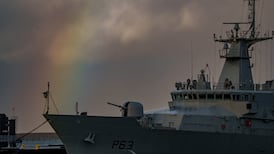ANALYSIS:Another motorcycle champion rider has been killed, but the lure of high speed racing on ordinary roads remains, writes Alastair McCook.
THE DEATH of Robert Dunlop, a hero to generations of Irish motorcycle fans, has once again plunged the closely-knit road racing fraternity into mourning only 12 days after Lusk's Martin Finnegan lost his life in a racing crash.
Dunlop's 250cc Honda seized and crashed at the 210km/h (130mph) Mathers Cross corner between Coleraine and Portrush, during practice for this weekend's North West 200 race. The accident happened at the exact spot where Dunlop's brother-in-law, Mervyn Robinson, was killed while competing in the North West 200 in 1980. Robinson's son Paul and Dunlop's sons Michael and William, as well as Sam Dunlop, son of Robert's brother Jim, were all riding in Thursday evening's ill-fated practice.
After the accident and as the sun set over Donegal away to the west, thousands of fans began to make their way home in grim silence. For many it was an all too familiar feeling as shock turned into numbed disbelief and finally to tears. Highly-tuned racing motorcycles are designed to be raced on purpose-built tracks where there is virtually nothing to hit if you fall off. And it is on these circuits, created and built with rider safety in mind, that the most competitive level of motorcycle racing, the Moto Grand Prix series, takes place.
In Moto Grand Prix there have been two racing fatalities in the last 20 years. In Ireland and the Isle of Man where racing on closed public roads thrives, the toll of fatalities runs to well over a dozen names in the last 10 years.
And yet in Ireland it is road racing that the fans still flock to see.
On most weekends throughout the racing season, at places like Athea, Skerries, Cookstown, Tandragee, Dundrod, and the Isle of Man, come rain or shine, the crowds line the hedgerows and banks to watch a sport that generates passions and loyalties that never waver or dissipate.
For the riders there is nothing like the thrill that comes from racing two-wheeled missiles that are capable of speeds in excess of 320km/h (200mph) on the same roads that the likes of me and you drive on to work, to do the shopping or take the children to school, most days of the year.
These are the roads, often tight, twisty and narrow country lanes, that are turned into race tracks once a year. They are lined with hedges, trees, banks, walls, houses and road signs. There are few soft landings in road racing and every chance that the slightest mistake will be severely punished.
Every rider knows the dangers, and most have been affected in some way by the harsh reality of the sport.
Robert Dunlop knew from first-hand experience the dangers involved. He had lost numerous friends, including his brother Joey, in racing accidents during his 30 years as a competitor. The catalogue of injuries that Robert had suffered prior to his fatal crash was extensive to say the least.
People on the outside dismiss road racers as simply mad. But they aren't. Far from it. However, they are addicts for the adrenaline rush that the sport gives them. They dedicate their lives in its pursuit and they convince themselves that it won't happen to them. They analyse and examine the circumstances and contributing factors to other racers' accidents, and the bottom line is always an explanation that allows their own belief and confidence in themselves to remain intact.
It is best summed up by New Zealand's road racing star of the 1980s, Graeme Crosby. In an interview he said that to be able to race and be competitive at the most dangerous circuit in the world, the Isle of Man, you needed to believe you were 10 feet tall and bulletproof.
All road racers think the same way - they couldn't walk on to the starting grid if they didn't. It's not that they don't know the risks, they accept them and put them to the back of their minds and get on with it, in the same way that a climber prepares for an ascent of K2 or Everest. While there are purpose-built racing circuits in Ireland, only Mondello Park comes near achieving the high standards expected in the rest of Europe.
In the North there has been talk for over 30 years of building a world class purpose-built circuit that would offer an alternative to road racing.
Tom Herron's death after a crash at the North West 200 in 1979 generated much debate about such a project, but in the end the talk fizzled out and came to nothing.
The truth is that it is these road events that most motorcycle racing fans want to watch. At purpose-built circuits spectators watch the action from a safe distance, behind high fencing that obscures the view and diminishes their excitement.
Only a few weeks ago, Robert told me: "I enjoy racing. I get a buzz out of it, but what keeps the buzz going is winning races, simple as that. If the thrill wasn't there I wouldn't do it any more."
Road racing fans scathingly refer to the short circuit version of the sport as "car park racing", and for most of them it holds little interest.
Balance that with the fact that the sport's governing body, the Motor Cycle Union of Ireland, is considered by many as unable to offer any strong leadership in its approach, and it is easy to understand why road racing in Ireland has changed little for decades.
The rest of the world has moved on; racing bikes are faster, tyre and suspension technologies are more advanced and sophisticated, and the circuits they race on are relatively safe.
In Ireland and the Isle of Man, the circuits have stayed much the same as they have always been.
...
Alastair McCook is a freelance writer and photographer








